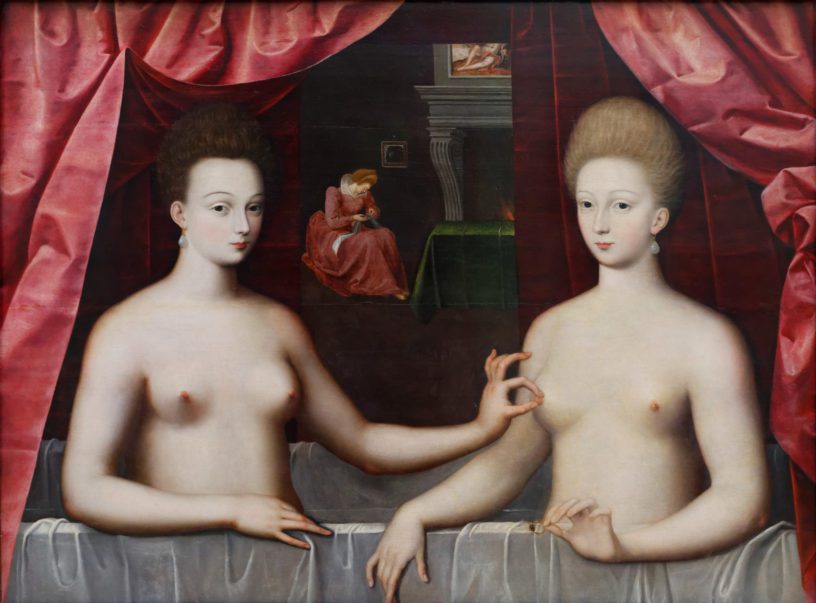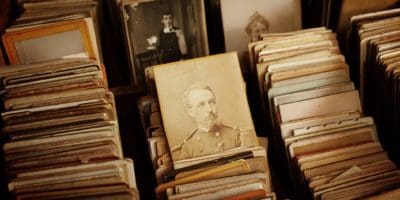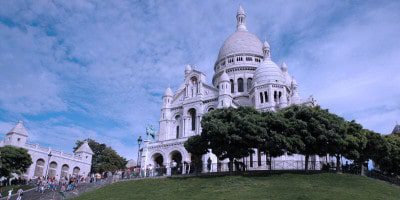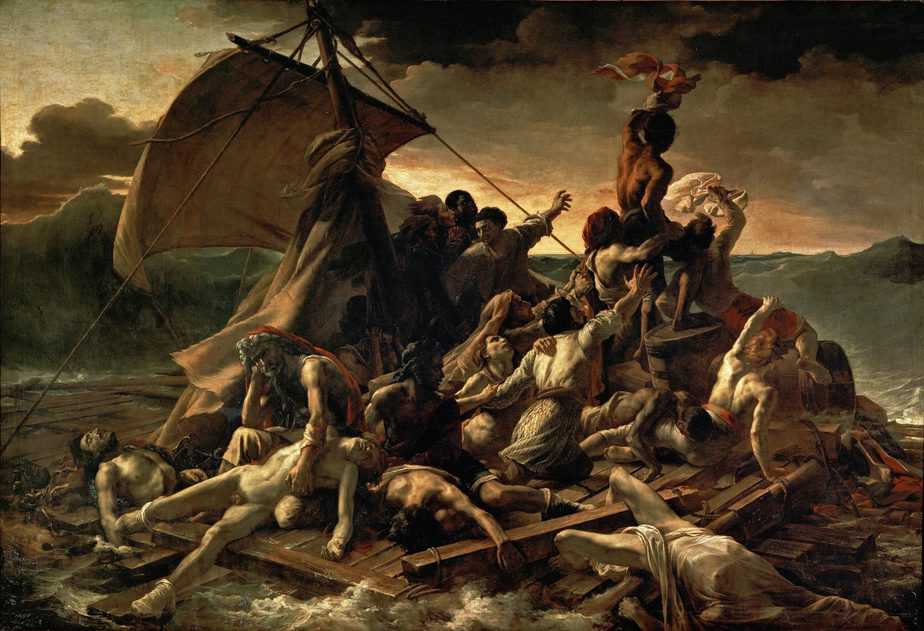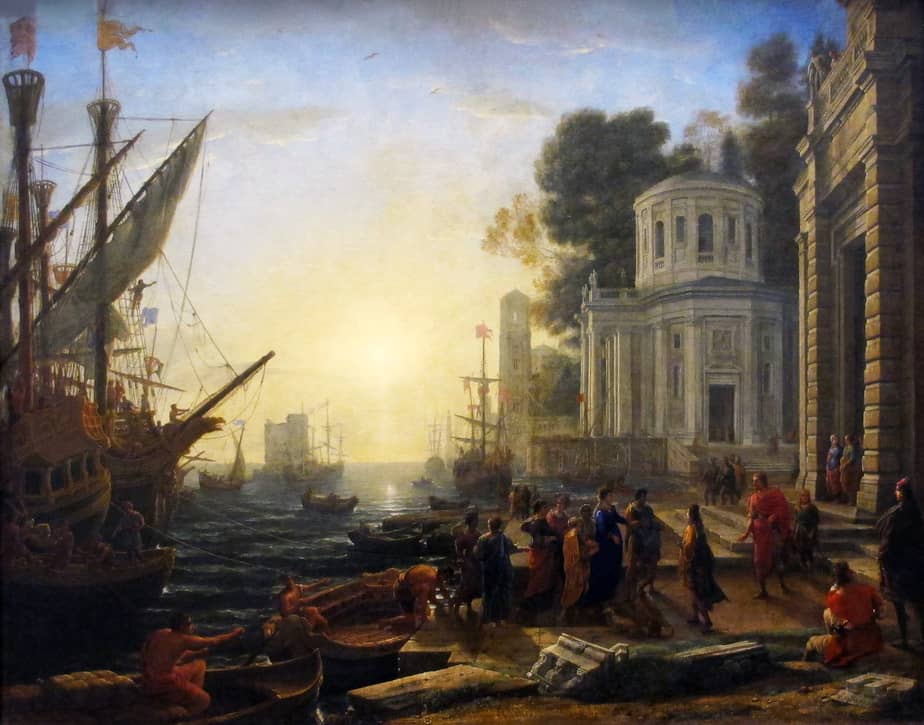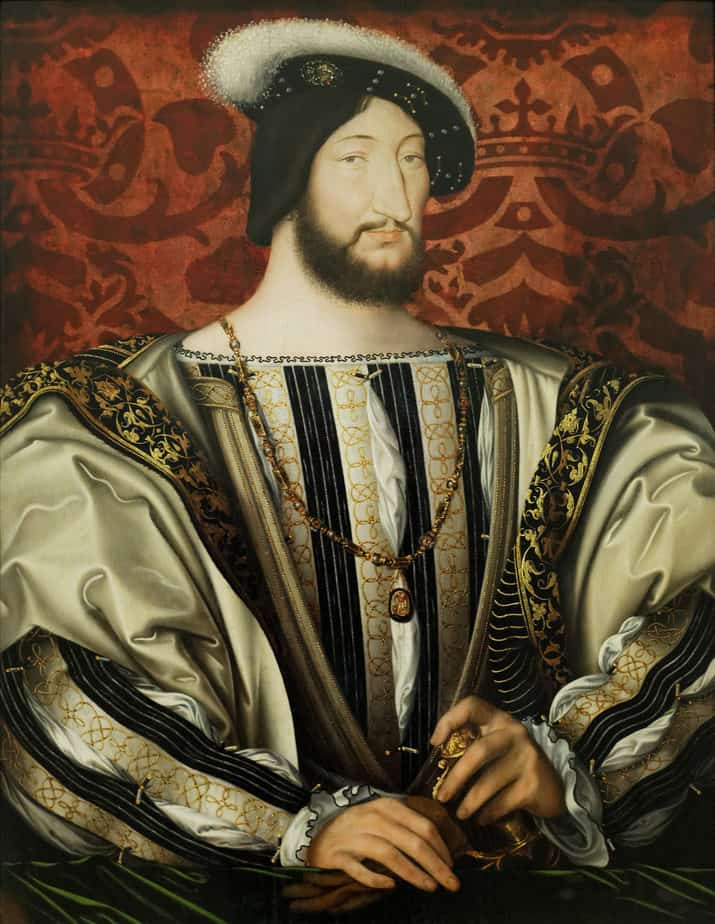10 Best French Paintings to See in the Louvre
Le Louvre is the biggest museum of French paintings even if it is famous for an Italian one. As a consequence, most visitors only see the large-scale French paintings of the XIXth century because they are on the way between the Mona Lisa and the exit.
The French paintings, from the XVIth century onwards were indeed inspired and stimulated by the Italians master of the Renaissance. But they managed to create their own style in beautiful masterpieces. Eventually in the XIXth century, France was setting the tone for western painting with the Romantic style.
Let’s discover 10 among the most beautiful and interesting!
1. The raft of the Medusa by Gericault
This painting is even more moving when you learn that it is based on a real event.
In 1816, a ship from France to Senegal ran aground on some sandbanks off the coast of Mauritania.
The crew and some passengers were able to take rescue boat whereas 146 men were left on a raft with almost no food and water. All but 15 died in the following 13 days of starvation and dehydration, while some committed cannibalism.
The look of the man holding the dead body of his son on his knee tells a lot about the state of mind of the survivors. However, on the right side, a black man on top of a pyramid of bodies tries to be visible from a vessel far on the horizon. The survivors were eventually rescued.
This tragedy caused a major political scandal. The captain Chaumereys, whose incompetence and scandalous behavior were responsible, had been appointed by the new monarchy because he was a noble.
The young Gericault knew that his painting would create some reaction and perhaps the controversy he needed to launched his career.
It was presented in 1819 in the official exhibition, the Salon de Paris. It sparked a lot of reactions and became the manifesto of a new style: Romanticism. Historical subjects were kept like in the old Neoclassical style but with much more emotion and violence in the painting.
Gericault, who died when he was 32 years old in 1824, was replaced at the head of the new romantic school by Delacroix.
2. The Liberty guiding the People by Delacroix
This painting is probably the most famous French painting. People often associate it with the famous Revolution starting in 1789. However, it represents another one, made in July 1830. A conservative monarchy, the Restoration, was replaced by a more liberal one, the Monarchy of July.
For 3 days, the “3 Glorious Days”, the Parisians led by the progressive opposition to the regime built barricade in the capital. The king Charles X had to exile and his cousin Louis-Philippe was proclaimed king at the balcony of the City Hall.
The painter Delacroix was mostly a bystander in this Revolution but decided to glorify it. He said:
“I did not fight for my country but I painted for it !”
The woman in the center is Marianne, an allegory of Liberty and symbol of the Revolution. Her breast is naked because she is a motherly figure.
This nudity did not cause a problem for the critics as the symbol was understood. However, the unshaved underarm was considered as vulgar by many !
On the sides, standing or fallen, different social categories that took part in this revolution: bourgeois, poor workers, soldiers.
Notice the kid on the right: he inspired one of Delacroix’s friend, the novelist Victor Hugo. He became the character of Gavroche, in his bestseller Les Misérables.
3. The coronation of Napoleon by David
This very impressive painting represents a famous event of 1804: the coronation of Napoleon in Notre-Dame.
There is no less than 191 figures representing all the dignitaries and members of the imperial family who were present that day.
There is even one who was not here: Letizia, mother of Napoleon that you can see on a chair in a balcony that was sulking on that day. Napoleon asked David to put her in the painting nonetheless.
Behind Napoleon, the pope Pie VII. He thought he was coming to crown the Emperor, as it was common in the western tradition. However, Napoleon, as a self-made man, wanted to crown himself. The pope, made a secondary character, was only here to pray for him.
There is only one actor in this painting: Napoleon crowning his wife Josephine, in a submissive pose. The artist David was very satisfied with the result. He said:
“We live, we walk, we speak in this painting”.
But David was never paid for his painting!
4. Portrait of Louis XIV in coronation robes by Hyacinthe Rigaud
Here is the most famous portrait of the most famous French king. Louis XIV, the Sun-King, builder of Versailles, was represented in 1701 when he was 63 years old.
This portrait was commissioned to Rigaud by his grand-son Philippe. As he was leaving Versailles to become king of Spain, he wanted to bring a souvenir of him.
But Louis XIV was so satisfied with the result that he chose to keep it in Versailles. It became the official portrait of the king and inspired all the portraits of his successors.
You can find in the painting all the symbols of the French monarchy: the fleur-de-lys, the crown, the scepter the hand of justice, the sword of Charlemagne, the necklace of the Order of the Holy Spirit. He wears all the attributes of his coronation, 48 years before.
Despite the marks of the age, Louis XIV is represented in a very positive manner. Look at his well-defined dancer’s legs. His imposing wig was only a way to hide his baldness but he made these wigs fashionable and completely indispensable for the courtiers.
5. The rapt of the Sabines women by Poussin
Nicolas Poussin is considered the most important French painter of the 17th century, when French culture was at its peak. He was the leader of the classical school, where artists took their inspirations from the Antiquity.
Here, the painting refers to an episode of the Roman mythology. In the beginning of Rome, the Romans lacked women and failed to negociate with their neighbors, the Sabines, to marry some of the Sabines women.
The Romans organized a trap and conducted a mass abduction of these women. After this violent event, the women were promised to be well-treated if they consented to stay and marry some Romans. They accepted.
This led to a war with the Sabines. The Sabines women stand in the middle of the two armies. They managed to reconciliate the two who decided to fuse to form one people.
This famous episode is used by Poussin to show his mastery in the design of both masculine and feminine body. You can also admire the composition: how he gave an impression of a panicked crowd.
6. The Disembarkation of Cleopatra at Tarsus by Gellée Le Lorrain
Like Poussin, the classical painter Gellée took his inspiration from Antiquity.
Here he showed Cleopatra disembarking at Tarsus to meet Mark Antony. The young and beautiful queen of Egypt, vassal of the mighty Roman Republic, is coming to seduce the Roman general and stateman. As she hoped, he fell in love with her.
According to some Roman historians, Mark Antony began to serve the Egyptian interests, at the detriment of Rome, before he is defeated by his rival Octavian Augustus. Their ambition destroyed, Antony and Cleopatra committed suicide together.
Like Poussin again, this evocation of the Antiquity is a pretext to paint a beautiful sunny harbor. The imaginary architecture reflects the harmony and equilibrium associated with Antiquity. The imposing galleons are closer from the boats existing at the time of the painting (1642). The work on the sunlight is the major concern of Claude Gellée.
Despite being the least famous painting of this list, I consider it is the most beautiful.
7. The Cheat with the Ace of Diamonds by La Tour
Here is one painting where the spectator is invited to participate by the look of the cheater. Georges de la Tour is here greatly inspired by the Italian master Caravaggio who painted the same theme earlier.
The scenario is made clear by the behavior of the characters. The cheater is producing an ace of diamond that will enable him to win the game and take the money of the young rich man on the right. The latter is too absorbed to notice the looks of complicity between the three others characters.
La Tour, like Caravaggio, play with the contrasts of the light in a technique called the chiaroscuro. Notice how the naïve but honest man is represented on a white background whereas the plotters are represented on a black one.
The pearl of the woman was at that time a symbol of prostitution. The features of the characters are also meant to reflects their personality: the sharpness of the cheater’s face shows his malice, the roundness of the young player’s face his naivety.
There was a moral in the story: young men should beware of gambling, wine and women!
8. Portrait of Gabrielle d’Estrées and one of her sister (anonymous)
This sensual painting received quickly the praise of the public, yet its author and the condition of its production remain unknown.
The two women have been identified as Gabrielle d’Estrées, mistress of Henri IV from 1590 to 1599 and her sister, the Duchess of Villars, on the left.
The style, known as the School of Fontainebleau, is inspired from the sensuality of the Italian Renaissance. At this time, the habit of taking shared baths, borrowed from Antiquity, was common for the aristocracy.
The Duchess of Villars is pinching the breast of Gabrielle to announce her pregnancy. In 1594 she had a son from Henri, César de Vendôme, who was even recognized by his father. Rumors has it that the king, madly in love with her, wanted to marry her. This could explain the ring that Gabrielle has in her hand.
Gabrielle was known as the “almost queen”. In 1590, she accepted to become his mistress, even though she was much younger and she found him ugly, under the pressure of her family.
She received a lot of gifts and titles from her lover but also attracted a lot of hatred. She died while she was delivering a baby. Was her death caused by the pregnancy? Many contemporaries believed she had been poisoned…
9. Portrait of François Ier by Clouet
Another portrait of a king: not the one of the majestic Louis XIV but of the more simple François Ier, lover of the art. François Ier is the king who brought the Renaissance from Italy to France. He invited Leonardo da Vinci among others artists and architects.
It is perhaps because of this love for Italian culture that François Ier is dressed like an Italian noble. The style and the composition of the portrait also reflect Italian art. Many of these artists were in the castle of Fontainebleau, south of Paris, where they influenced French artists like Jean Clouet.
The originality of the portrait is that it is the first king’s portrait where the king is looking at the spectator.
Unlike Louis XIV, he does not wear the attributes of his power. The crown is only present in the red curtains. However, François Ier does wear the necklace of Saint-Michel, an order of chivalry he presided.
You can tell from the portrait that François was very tall: 1,98m or 6’5. That made him a giant for the standards of the XVIth century. No French head of state beat him in that regard in five centuries.
He loved to use his size and strength but sometimes it was to his detriment: in 1520 during a wrestling tournament he humiliated the English king Henry VIII. Observers said it plays a role in the decision of the defeated king to prefer an alliance with the enemy of François, the Emperor Charles V.
10. The skate by Chardin
Let’s finish with a still life! The French master of this type of painting was Jean-Siméon Chardin. He presented this piece in 1728 to be accepted in the Royal Academy of Painting.
The look of this skate and the composition of the painting have fascinated the art critics and the public since then. There are three pyramids in this painting: the pyramid of the living on the left with the bristling cat and the oysters, the pyramid of the inanimate on the right with the objects and the triangular skate makes the transition. The handle of the knife seems to go out of the painting and give an impression of depth.
Jean-Siméon Chardin did not care that much about the subjects of his painting. These subjects were considered as an opportunity for an exercise in style and this is a success! Though I admit being usually indifferent to the still life, I can stay hypnotized in front of this painting for very long.
This overview is now finished but with some regrets. For this short selection I had to ignore several great masters: Vouet, Fragonard, Boucher, Ingres…
I invite you to take the time to see them yourself. You are lucky: most of them are situated in parts of Le Louvre that are not that crowded. Don’t hesitate to take a tour to get the most of it and perhaps I will see you there!
Planning a trip to Paris ? Get ready !
These are Amazon’s best-selling travel products that you may need for coming to Paris.
Bookstore
- The best travel book : Rick Steves – Paris 2023 – Learn more here
- Fodor’s Paris 2024 – Learn more here
Travel Gear
- Venture Pal Lightweight Backpack – Learn more here
- Samsonite Winfield 2 28″ Luggage – Learn more here
- Swig Savvy’s Stainless Steel Insulated Water Bottle – Learn more here
Check Amazon’s best-seller list for the most popular travel accessories. We sometimes read this list just to find out what new travel products people are buying.

